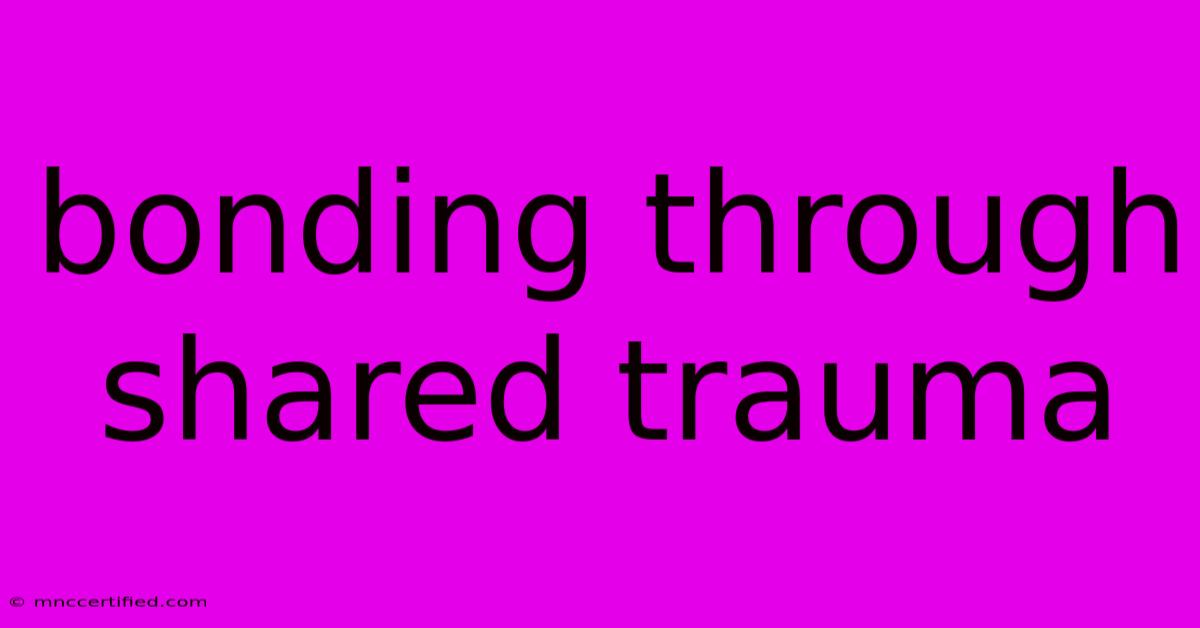Bonding Through Shared Trauma

Table of Contents
Bonding Through Shared Trauma: The Complexities of Post-Traumatic Growth
Trauma, in its various forms, can leave lasting scars. Yet, paradoxically, shared experiences of trauma can also foster surprisingly strong bonds between individuals. This phenomenon, while often overlooked, is a complex interplay of emotional, psychological, and social factors. Understanding this process is crucial for supporting those who have endured trauma and fostering healthy recovery.
The Power of Shared Understanding
One of the most significant aspects of bonding after shared trauma is the profound sense of understanding it creates. When individuals have experienced similar traumatic events, they possess a unique shared language, a tacit understanding that transcends the need for extensive explanation. This unspoken connection can be incredibly comforting and validating, especially when dealing with a trauma that feels isolating and difficult to articulate to those who haven't lived through it.
- Feeling "seen": This shared understanding allows individuals to feel truly "seen" and understood, a critical need after a traumatic experience. The feeling of not being alone in one's suffering is powerful.
- Reduced shame and stigma: Openly sharing experiences with others who understand can reduce feelings of shame, guilt, and stigma often associated with trauma. The shared experience normalizes the feelings and reactions, reducing the sense of isolation.
- Validation of experiences: Sharing experiences validates the reality of the trauma and the individual's reactions to it. This validation is especially important when dealing with disbelief or minimization from others.
The Mechanisms of Post-Traumatic Bonding
The process of bonding through shared trauma isn't always straightforward. Several mechanisms contribute to this phenomenon:
1. Emotional Regulation Through Shared Experience
Facing a traumatic event together can lead to a powerful sense of mutual support and emotional regulation. Sharing feelings, coping mechanisms, and processing the experience collectively can create a sense of safety and stability. This is particularly true in situations like natural disasters or military deployments where individuals develop close bonds under extreme stress.
2. Mutual Support and Reciprocal Help
Shared trauma often leads to reciprocal help and support. Individuals may find strength in helping others process their trauma, finding healing in the act of providing comfort and understanding. This mutual support network is a vital part of the recovery process and can solidify the bond between individuals.
3. Creating Meaning from Trauma
For some, finding meaning in their shared trauma becomes a powerful bonding agent. By collectively processing their experiences and finding ways to contribute positively to the world in the wake of trauma, individuals can transform their suffering into something meaningful. This shared sense of purpose can deeply strengthen their connection.
Potential Downsides and Complications
It's essential to acknowledge that bonding through shared trauma isn't always positive. While it can be a source of strength and resilience, it can also have potential downsides:
- Re-traumatization: Reliving the traumatic experience through constant sharing can lead to re-traumatization and hinder the healing process. Healthy boundaries and careful pacing of shared experiences are crucial.
- Toxic relationships: Shared trauma can inadvertently foster unhealthy dynamics, such as co-dependency or enmeshment. Maintaining individuality and healthy relationships outside the shared trauma group is vital.
- Difficulty separating: The intense bond formed through shared trauma can make it difficult for individuals to separate and move on independently, hindering personal growth and independence.
Fostering Healthy Bonding After Trauma
Creating healthy support systems after trauma is crucial. This involves:
- Seeking professional help: Therapy, group therapy, or support groups specifically designed for trauma survivors can provide a safe and supportive environment for processing experiences.
- Building healthy boundaries: Learning to establish healthy boundaries in relationships is crucial to prevent co-dependency and ensure individual well-being.
- Focusing on self-care: Prioritizing self-care activities that promote emotional and physical well-being is essential for healthy recovery and building strong relationships.
Conclusion:
Bonding through shared trauma is a complex process with both positive and negative aspects. Understanding the mechanisms involved, acknowledging potential pitfalls, and fostering healthy support systems are crucial for survivors to navigate this challenging journey toward healing and growth. Remember, seeking professional help is a sign of strength, not weakness, and it can significantly contribute to a healthier and more fulfilling recovery.

Thank you for visiting our website wich cover about Bonding Through Shared Trauma. We hope the information provided has been useful to you. Feel free to contact us if you have any questions or need further assistance. See you next time and dont miss to bookmark.
Featured Posts
-
Swimming Pool Bonding Diagram
Nov 28, 2024
-
Uefa Youth League 2 0 Juventus Victory
Nov 28, 2024
-
Stores Open Thanksgiving Near Me H E B Check
Nov 28, 2024
-
Kittery Trading Post Used Guns
Nov 28, 2024
-
Lebanon Ceasefire Displaced Return Home
Nov 28, 2024